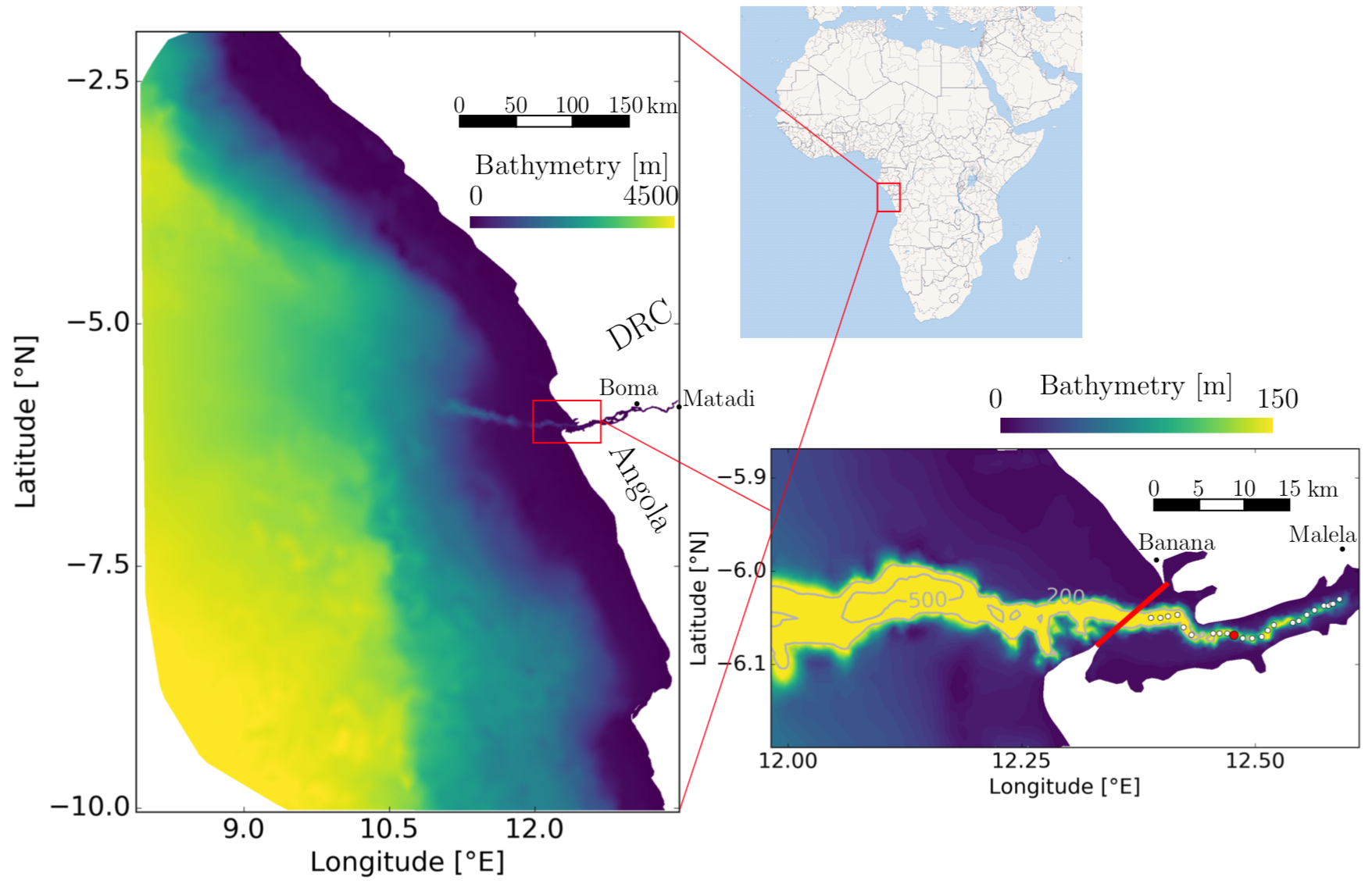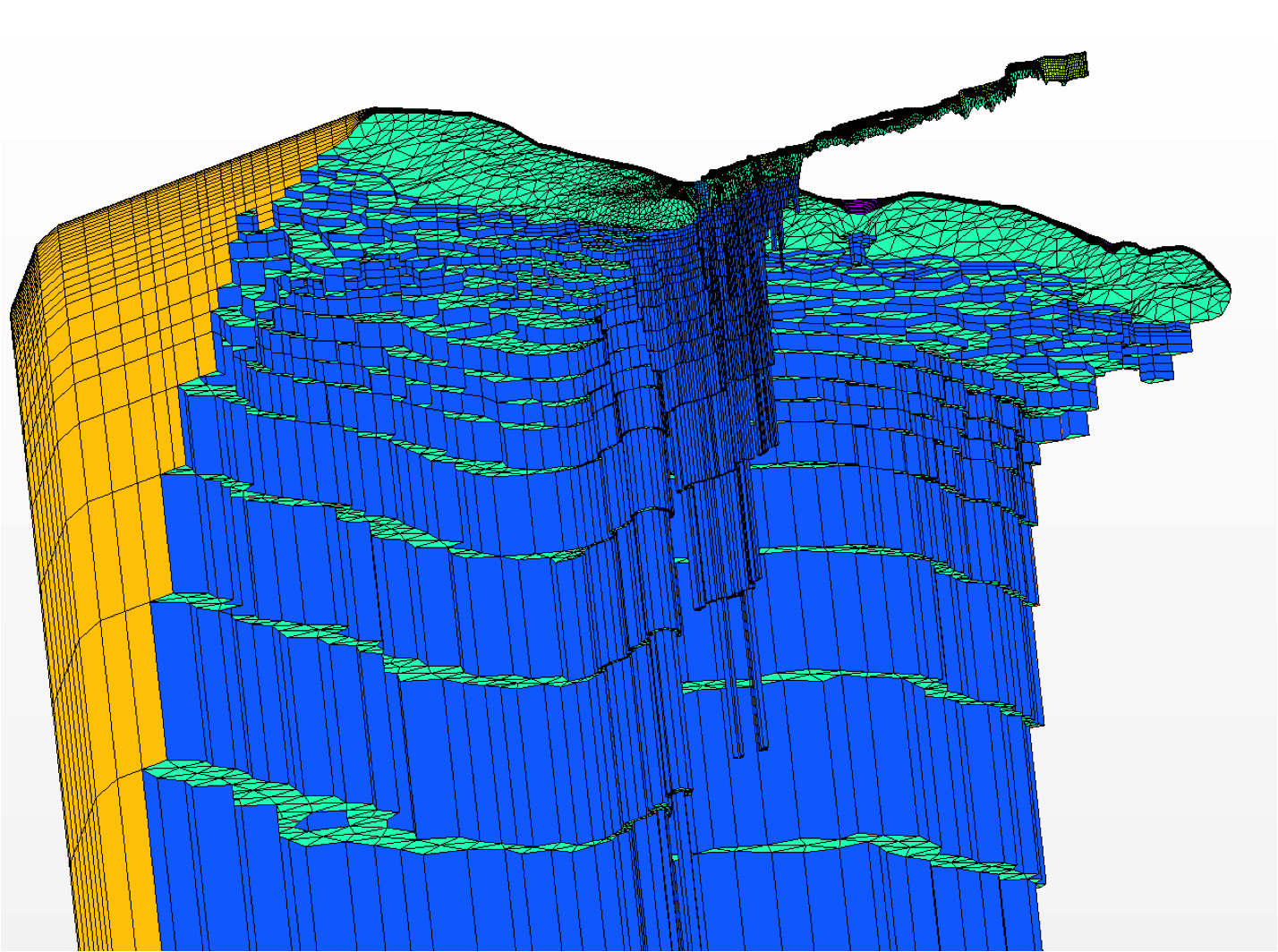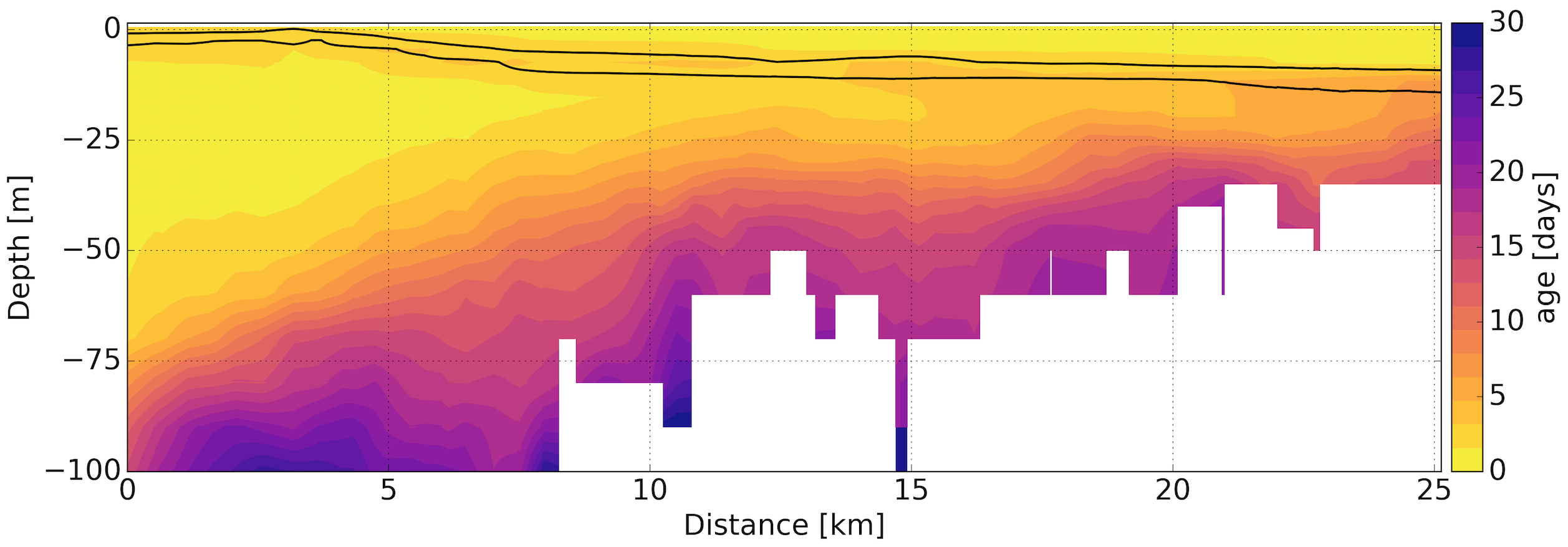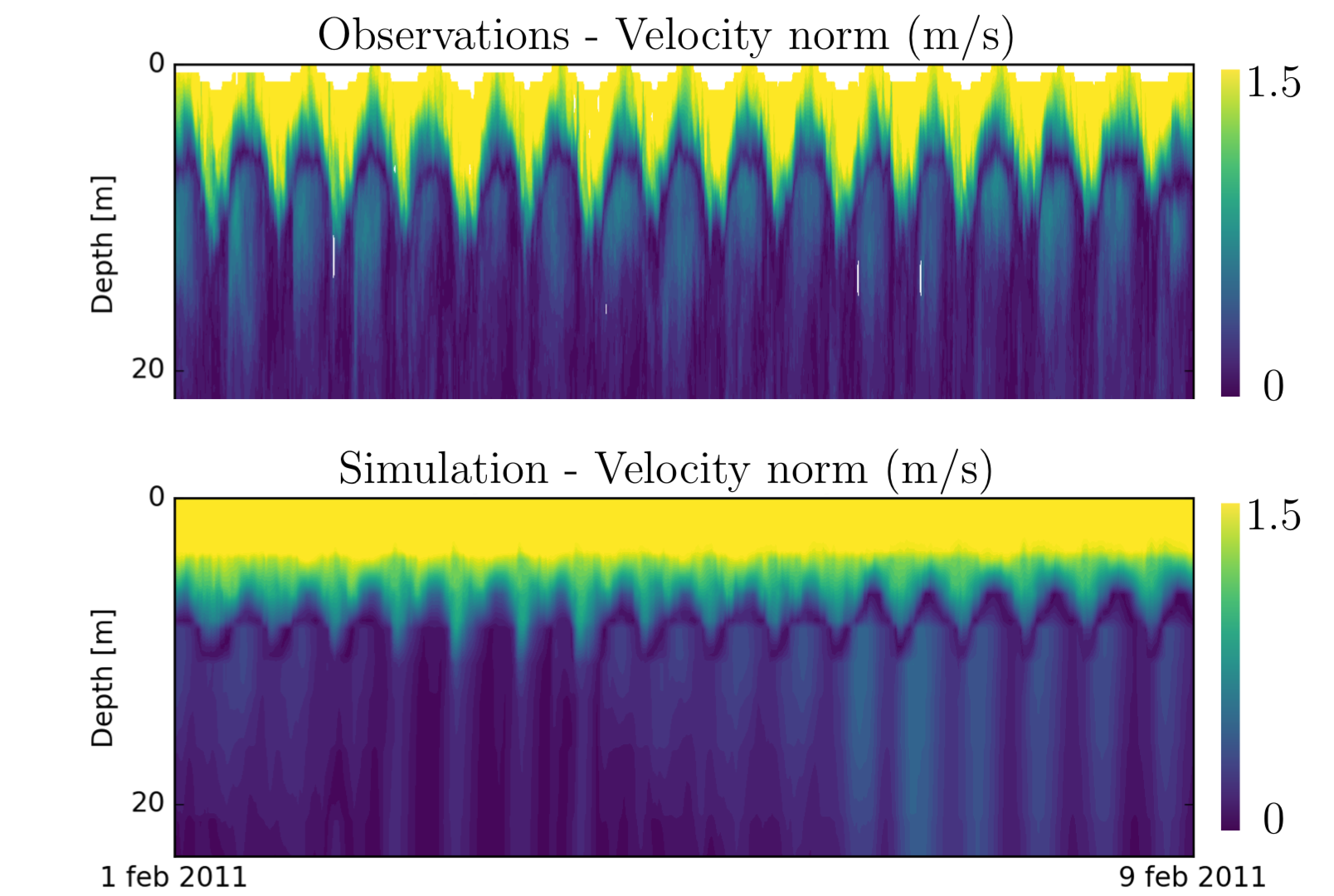The Congo River is the second largest river in the world in terms of both watershed and mean river discharge, after the Amazon River. The river mouth is characterised by a deep submarine canyon cutting through the shelf, which directly connects the estuary with the deep ocean.

The presence of this deep canyon strongly constrains the mesh generation. Here we had to use an anisotropic mesh on the horizontal combined with a mix of sigma layers in the first 10 meters and z layers below. These z layers had to be built very carefully to correctly approximate the canyon and hence accurately model the 3D dynamics.

The estuarine dynamics is characteristic of a strong exchange flow, with a thin layer of freshwater moving downstream on top of a thick layer of saline waters going towards the river. The tidal energy input and the large depth of the canyon induce a strong stratification between both layers. There is very little water renewal at the bottom of the estuary, due to the low vertical mixing. The renewing water age highlights that the maximum age of the brackish waters at about 10m depth is a local maximum far lower than the large age observed in deeper regions (> 1 month). Combined with the presence of high particulate matter concentrations and bacterial activities, the model results agree with the hypoxic conditions observed near the bottom of the canyon.

The figure below shows a comparison between model results and observations of the vertical velocity profile. The observations are obtained from ADCP profile measurements at a location right at the end of the estuary, near the submarine canyon. SLIM3D shows very good results in this topographically challenging environment.

To learn more…
778265
congo
1
apa
50
date
desc
4783
https://www.slim-ocean.be/wp-content/plugins/zotpress/
%7B%22status%22%3A%22success%22%2C%22updateneeded%22%3Afalse%2C%22instance%22%3Afalse%2C%22meta%22%3A%7B%22request_last%22%3A0%2C%22request_next%22%3A0%2C%22used_cache%22%3Atrue%7D%2C%22data%22%3A%5B%7B%22key%22%3A%22NH4E9UBK%22%2C%22library%22%3A%7B%22id%22%3A778265%7D%2C%22meta%22%3A%7B%22creatorSummary%22%3A%22Vallaeys%20et%20al.%22%2C%22parsedDate%22%3A%222021%22%2C%22numChildren%22%3A1%7D%2C%22bib%22%3A%22%26lt%3Bdiv%20class%3D%26quot%3Bcsl-bib-body%26quot%3B%20style%3D%26quot%3Bline-height%3A%202%3B%20padding-left%3A%201em%3B%20text-indent%3A-1em%3B%26quot%3B%26gt%3B%5Cn%20%20%26lt%3Bdiv%20class%3D%26quot%3Bcsl-entry%26quot%3B%26gt%3BVallaeys%2C%20V.%2C%20Lambrechts%2C%20J.%2C%20Delandmeter%2C%20P.%2C%20P%26%23xE4%3Btsch%2C%20J.%2C%20Spitzy%2C%20A.%2C%20Hanert%2C%20E.%2C%20%26amp%3B%20Deleersnijder%2C%20E.%20%282021%29.%20Understanding%20the%20circulation%20in%20the%20deep%2C%20micro-tidal%20and%20strongly%20stratified%20Congo%20River%20estuary.%20%26lt%3Bi%26gt%3BOcean%20Modelling%26lt%3B%5C%2Fi%26gt%3B%2C%20101890.%20%26lt%3Ba%20class%3D%26%23039%3Bzp-DOIURL%26%23039%3B%20href%3D%26%23039%3Bhttps%3A%5C%2F%5C%2Fdoi.org%5C%2F10.1016%5C%2Fj.ocemod.2021.101890%26%23039%3B%26gt%3Bhttps%3A%5C%2F%5C%2Fdoi.org%5C%2F10.1016%5C%2Fj.ocemod.2021.101890%26lt%3B%5C%2Fa%26gt%3B%26lt%3B%5C%2Fdiv%26gt%3B%5Cn%26lt%3B%5C%2Fdiv%26gt%3B%22%2C%22data%22%3A%7B%22itemType%22%3A%22journalArticle%22%2C%22title%22%3A%22Understanding%20the%20circulation%20in%20the%20deep%2C%20micro-tidal%20and%20strongly%20stratified%20Congo%20River%20estuary%22%2C%22creators%22%3A%5B%7B%22creatorType%22%3A%22author%22%2C%22firstName%22%3A%22Valentin%22%2C%22lastName%22%3A%22Vallaeys%22%7D%2C%7B%22creatorType%22%3A%22author%22%2C%22firstName%22%3A%22Jonathan%22%2C%22lastName%22%3A%22Lambrechts%22%7D%2C%7B%22creatorType%22%3A%22author%22%2C%22firstName%22%3A%22Philippe%22%2C%22lastName%22%3A%22Delandmeter%22%7D%2C%7B%22creatorType%22%3A%22author%22%2C%22firstName%22%3A%22Johannes%22%2C%22lastName%22%3A%22P%5Cu00e4tsch%22%7D%2C%7B%22creatorType%22%3A%22author%22%2C%22firstName%22%3A%22Alejandro%22%2C%22lastName%22%3A%22Spitzy%22%7D%2C%7B%22creatorType%22%3A%22author%22%2C%22firstName%22%3A%22Emmanuel%22%2C%22lastName%22%3A%22Hanert%22%7D%2C%7B%22creatorType%22%3A%22author%22%2C%22firstName%22%3A%22Eric%22%2C%22lastName%22%3A%22Deleersnijder%22%7D%5D%2C%22abstractNote%22%3A%22The%20Congo%20River%20estuary%20is%20characterised%20by%20a%20deep%20canyon%20that%20connects%20the%20river%20to%20the%20deep%20ocean%20by%20cutting%20through%20the%20continental%20shelf.%20Its%20estuary%20is%20influenced%20by%20high%20river%20discharge%20and%20micro-tidal%20conditions%2C%20with%20a%20large%20depth%20and%20limited%20vertical%20mixing.%20This%20restricts%20the%20supply%20of%20oxygen%20from%20the%20surface%20waters%20to%20the%20more%20saline%20bottom%20waters%2C%20leading%20to%20hypoxic%20and%20anoxic%20zones.%20We%20study%20the%20dynamics%20of%20the%20Congo%20River%20estuary%20by%20applying%20the%20multi-scale%20baroclinic%20coastal%20ocean%20model%20SLIM%203D%20%28www.slim-ocean.be%29%20to%20this%20topographically%20challenging%20environment.%20By%20allowing%20a%20high%20degree%20of%20flexibility%20in%20the%20representation%20of%20both%20the%20complex%20geometry%20and%20the%20strong%20stratification%2C%20SLIM%203D%20is%20able%20to%20simulate%20riverine%2C%20tidal%20and%20gravitational%20processes%20that%20drive%20the%20estuarine%20circulation.%20Model%20results%20compare%20favourably%20with%20in-situ%20data%20in%20the%20estuary%2C%20suggesting%20that%20the%20exchange%20flow%20is%20correctly%20simulated.%20The%20latter%20is%20characterised%20by%20a%20two-layer%20dynamics.%20The%20combination%20of%20the%20large%20river%20discharge%2C%20the%20strong%20stratification%20and%20the%20large%20depth%20results%20in%20a%20moderate%20freshwater%20Froude%20number%20and%20a%20very%20small%20mixing%20number.%20It%20makes%20the%20Congo%20River%20an%20outlier%20in%20state-of-the-art%20estuarine%20classifications%2C%20closer%20to%20fjords%20than%20salt%20wedge%20estuaries.%20Furthermore%2C%20using%20the%20age%20as%20a%20diagnosis%20sheds%20light%20on%20the%20spatial%20variability%20of%20the%20estuarine%20waters%20ventilation.%20Local%20maximum%20of%20renewing%20water%20age%20located%20just%20below%20the%20pycnocline%20is%20exceeded%20by%20old%20dense%20oceanic%20waters%20which%20stagnate%20at%20the%20bottom%20of%20the%20canyon%20for%20more%20than%20two%20months%20due%20to%20the%20small%20vertical%20mixing.%20It%20helps%20explain%20the%20hypoxic%20and%20anoxic%20conditions%20observed%20at%20the%20bottom%20of%20the%20submarine%20canyon.%22%2C%22date%22%3A%229%5C%2F2021%22%2C%22language%22%3A%22en%22%2C%22DOI%22%3A%2210.1016%5C%2Fj.ocemod.2021.101890%22%2C%22ISSN%22%3A%2214635003%22%2C%22url%22%3A%22https%3A%5C%2F%5C%2Flinkinghub.elsevier.com%5C%2Fretrieve%5C%2Fpii%5C%2FS1463500321001438%22%2C%22collections%22%3A%5B%22GJSQZPDC%22%5D%2C%22dateModified%22%3A%222021-09-24T16%3A12%3A02Z%22%7D%7D%2C%7B%22key%22%3A%22W95GT4DY%22%2C%22library%22%3A%7B%22id%22%3A778265%7D%2C%22meta%22%3A%7B%22creatorSummary%22%3A%22Le%20Bars%20et%20al.%22%2C%22parsedDate%22%3A%222016%22%2C%22numChildren%22%3A2%7D%2C%22bib%22%3A%22%26lt%3Bdiv%20class%3D%26quot%3Bcsl-bib-body%26quot%3B%20style%3D%26quot%3Bline-height%3A%202%3B%20padding-left%3A%201em%3B%20text-indent%3A-1em%3B%26quot%3B%26gt%3B%5Cn%20%20%26lt%3Bdiv%20class%3D%26quot%3Bcsl-entry%26quot%3B%26gt%3BLe%20Bars%2C%20Y.%2C%20Vallaeys%2C%20V.%2C%20Deleersnijder%2C%20%26%23xC9%3B.%2C%20Hanert%2C%20E.%2C%20Carrere%2C%20L.%2C%20%26amp%3B%20Channeli%26%23xE8%3Bre%2C%20C.%20%282016%29.%20Unstructured-mesh%20modeling%20of%20the%20Congo%20river-to-sea%20continuum.%20%26lt%3Bi%26gt%3BOcean%20Dynamics%26lt%3B%5C%2Fi%26gt%3B%2C%20%26lt%3Bi%26gt%3B66%26lt%3B%5C%2Fi%26gt%3B%284%29%2C%20589%26%23x2013%3B603.%20%26lt%3Ba%20class%3D%26%23039%3Bzp-DOIURL%26%23039%3B%20href%3D%26%23039%3Bhttps%3A%5C%2F%5C%2Fdoi.org%5C%2F10.1007%5C%2Fs10236-016-0939-x%26%23039%3B%26gt%3Bhttps%3A%5C%2F%5C%2Fdoi.org%5C%2F10.1007%5C%2Fs10236-016-0939-x%26lt%3B%5C%2Fa%26gt%3B%26lt%3B%5C%2Fdiv%26gt%3B%5Cn%26lt%3B%5C%2Fdiv%26gt%3B%22%2C%22data%22%3A%7B%22itemType%22%3A%22journalArticle%22%2C%22title%22%3A%22Unstructured-mesh%20modeling%20of%20the%20Congo%20river-to-sea%20continuum%22%2C%22creators%22%3A%5B%7B%22creatorType%22%3A%22author%22%2C%22firstName%22%3A%22Yoann%22%2C%22lastName%22%3A%22Le%20Bars%22%7D%2C%7B%22creatorType%22%3A%22author%22%2C%22firstName%22%3A%22Valentin%22%2C%22lastName%22%3A%22Vallaeys%22%7D%2C%7B%22creatorType%22%3A%22author%22%2C%22firstName%22%3A%22%5Cu00c9ric%22%2C%22lastName%22%3A%22Deleersnijder%22%7D%2C%7B%22creatorType%22%3A%22author%22%2C%22firstName%22%3A%22Emmanuel%22%2C%22lastName%22%3A%22Hanert%22%7D%2C%7B%22creatorType%22%3A%22author%22%2C%22firstName%22%3A%22Loren%22%2C%22lastName%22%3A%22Carrere%22%7D%2C%7B%22creatorType%22%3A%22author%22%2C%22firstName%22%3A%22Claire%22%2C%22lastName%22%3A%22Channeli%5Cu00e8re%22%7D%5D%2C%22abstractNote%22%3A%22%22%2C%22date%22%3A%224%5C%2F2016%22%2C%22language%22%3A%22en%22%2C%22DOI%22%3A%2210.1007%5C%2Fs10236-016-0939-x%22%2C%22ISSN%22%3A%221616-7341%2C%201616-7228%22%2C%22url%22%3A%22http%3A%5C%2F%5C%2Flink.springer.com%5C%2F10.1007%5C%2Fs10236-016-0939-x%22%2C%22collections%22%3A%5B%22GJSQZPDC%22%5D%2C%22dateModified%22%3A%222018-10-21T09%3A54%3A43Z%22%7D%7D%5D%7D
Vallaeys, V., Lambrechts, J., Delandmeter, P., Pätsch, J., Spitzy, A., Hanert, E., & Deleersnijder, E. (2021). Understanding the circulation in the deep, micro-tidal and strongly stratified Congo River estuary.
Ocean Modelling, 101890.
https://doi.org/10.1016/j.ocemod.2021.101890
Le Bars, Y., Vallaeys, V., Deleersnijder, É., Hanert, E., Carrere, L., & Channelière, C. (2016). Unstructured-mesh modeling of the Congo river-to-sea continuum.
Ocean Dynamics,
66(4), 589–603.
https://doi.org/10.1007/s10236-016-0939-x



